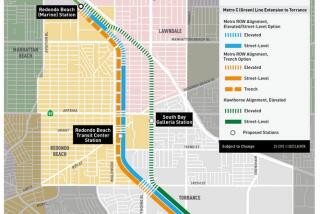Opposition May Stymie Plan to Cut Interchange Traffic
A plan to cut traffic at Ventura’s crowded Seaward Avenue interchange may be scaled back significantly because of intense opposition from local homeowners.
A City Council committee recommended Friday scuttling plans for a new on-ramp near the Seaward Avenue and Ventura Freeway intersection, a key component in a city and Caltrans plan to improve traffic flow at the city’s second-most-crowded intersection. The committee--composed of Councilmen Jim Monahan and Jack Tingstrom and Mayor Tom Buford--agreed with angry Ventura Keys residents, who argued that a Peninsula Street on-ramp would crowd their streets with unwanted cars and lower their property values.
The committee’s recommendation is expected to be considered by the full council in September.
Some Keys residents said they were delighted with the committee’s decision.
“I’m very happy to hear what I hear this morning,” said Suzy Clark, who lives on Peninsula Street.
But Jim Gonzalez, owner of the At The Beach bikini shop on Seaward and a Keys resident, said he favors the Peninsula on-ramp because it would help break the traffic bottleneck at Seaward, which is a principal route to Ventura State Beach.
“Anytime you divide (traffic) up, it will make it freer,” Gonzalez said.
The Seaward project without the Peninsula on-ramp would cost the California Department of Transportation $6.5 million to $8 million, and construction would not begin until at least 1997, city traffic engineer Nazir Lalani said.
In fact, construction could start as late as 1999 because Caltrans is so overwhelmed with seismic retrofitting projects statewide, Lalani said.
Ever since news of the redesign became known in May, the well-organized Ventura Keys homeowners have lobbied the council and testified against the Peninsula on-ramp at hearings.
Owners of the posh canal homes say the on-ramp would increase traffic on Peninsula Street, which cuts through the Keys, and erode area home values.
City engineers report that the on-ramp would increase traffic on Peninsula by 800 trips a day, from 4,800 to 5,600.
The City Council already considered the project last month, but postponed voting on it so the council’s traffic committee could further examine the issue.
City engineers earlier recommended adding the Peninsula on-ramp, because it would cut traffic at the intersection of Seaward Avenue and Harbor Boulevard by 350 cars an hour in peak hours. Peninsula Street is about one-quarter mile southeast of Seaward.
But Caltrans officials said the Peninsula on-ramp may create political problems greater than the traffic problems it will solve.
“The Peninsula option has the potential of delaying the project” because homeowner opposition and environmental reviews may bog it down for years, said Douglas R. Failing, Caltrans’ deputy district director.
Instead of the new on-ramp, city engineers have proposed new turn lanes in 15 to 20 years to handle increased traffic. But even two extra turn lanes will be only about half as effective as the Peninsula Street on-ramp, Lalani said.
One right-turn lane would cut into a vacant lot on Harbor Boulevard north of Seaward Avenue.
But the other lane would snatch a strip of property from the Chevron gas station, where it fronts Seaward west of Harbor Boulevard.
Chevron officials could not be reached for comment.
The plan approved by the committee would:
* Retrofit and widen the bridge over the freeway from five to eight lanes.
* Widen the northbound off-ramp on Seaward to include an extra right-turn lane and left-turn lane.
* Add an extra left-turn lane on southbound Harbor Boulevard at Seaward.
* Add another through lane and another right-turn lane on northbound Harbor Boulevard at Seaward.
More to Read
Sign up for Essential California
The most important California stories and recommendations in your inbox every morning.
You may occasionally receive promotional content from the Los Angeles Times.










